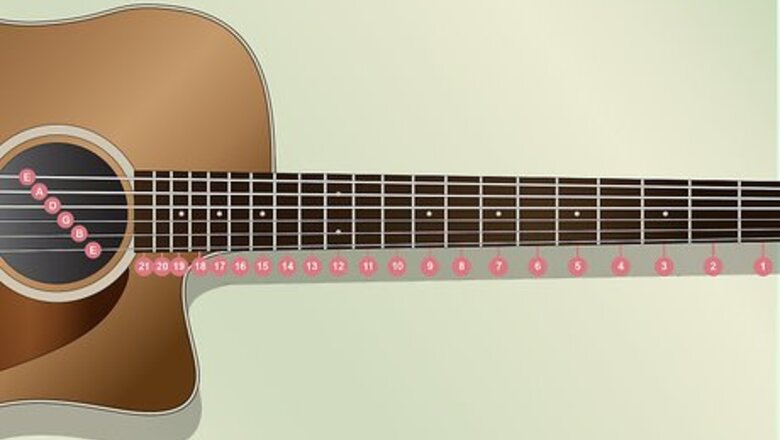
views
Understanding Chords

Learn the strings. The best way to start is by becoming familiar with the strings on your guitar and how they relate to your fingers. To make this easier, we're going to number them both. The strings on your guitar are numbered like this: Vertically, the strings are numbered 1 through 6, from highest pitch to lowest. Horizontally, the numbering is based on the fret positions. Note that when the directions say "put your first finger on the 3rd fret," that means you actually place your finger between the 2nd and 3rd fret. It's the string itself that needs to be in contact with the 3rd fret.Use this mnemonic to remember which note each string is tuned to, from lowest pitch (top string) to highest pitch (bottom string):Eat All Day, Get Big Easy.
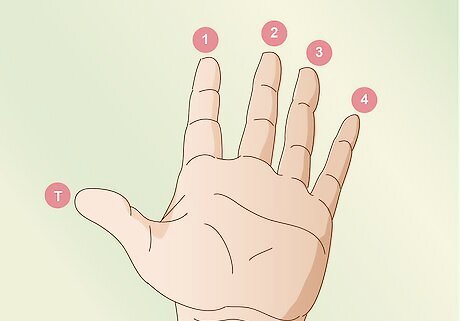
Number your fingers. Take a look at your left hand, and imagine you have numbers stamped on your fingers. Your index is 1, your middle finger is 2, your ring finger is 3, and your pinky finger is 4. Your thumb we will call "T," but you will not be using it for chords in this article.
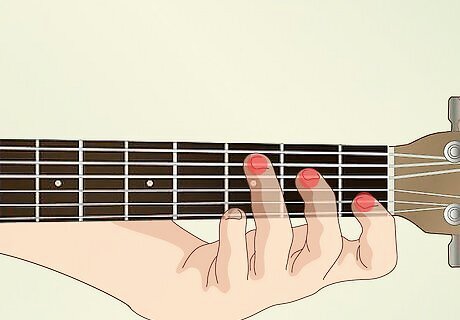
Learn the C chord. The first chord we will cover is a C chord—one of the most basic chords in music. Before we do, let's break down just what that means. A proper chord, whether played on a piano, a guitar, or sung by well-trained mice, is simply three or more notes sounded together. (Two notes is called a "diad," and while musically useful, is not a chord.) Chords can also contain far more than three notes, but that's well beyond the scope of this article. This is what a C chord looks like on the guitar: The lowest note is the 3rd fret of the A string: C The next note up is played on the 2nd fret of the D string: E Note there is no finger on the G string. This string remains "open" when strumming a C. The highest note is played on the 1st fret of the B string: C The highest and lowest strings on the guitar are not played for the basic C major chord.
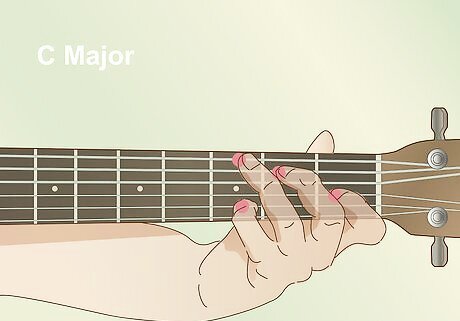
Try it out the notes. Play each note in the chord, from low to high, one at a time. Take your time and be deliberate: press down firmly on the fret, and pluck the string. Let the note ring for as long as you can, then move to the next note: Press your 3rd finger onto the 3rd fret of the A string, as indicated above, pluck, and let it ring until it fades out. You just played a C note. Press your 2nd finger onto the 2nd fret of the D string, then do the pluck-and-ring to play an E. Break time! Simply pluck the open, un-fingered G string. Press your 1st finger on the 1st fret of the B string, and let that C note sound loud! Play the notes, one at a time, for a few times. When you're ready, sweep your pick or fingers across all four middle strings quickly. You've just played a C chord! It may sting a little the first few times you do it, but as you develop calluses, the pain goes away.
Learning More Chords
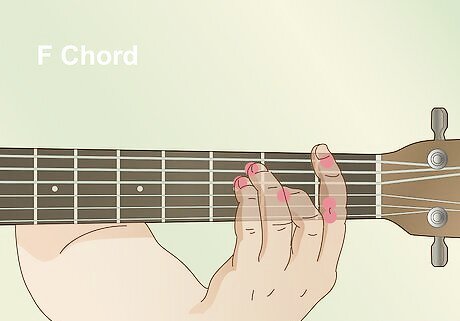
Expand your musical vocabulary. Playing a C chord is nice, and it's definitely a gateway chord that will lead you into more interesting musical territory, but there's much more to music than that! Here are two other chords commonly used when playing in C Major. F, and G. Play a basic F chord like this: The notes in an F chord are F, A, and C. Note that the F and the C are being played by the same finger: the first finger is placed across the 1st fret of both the 1st and 2nd strings. Generally, chords are built so that the lowest note is the root of the chord, but in this case, the F is being sounded on the 1st fret of the 1st string. This is called an "inversion." Demystify the fretboard for beginners. "I had no experience with guitar growing up. This article clearly explained how to number the frets and strings, which demystified the fretboard for me as a beginner. Now, I can understand chord diagrams better. The foundations here fulfilled my goal to learn guitar later in life." - Jayaraman S. Master chord fundamentals. "I knew some chords from friends but had gaps in understanding how they fit together. This article tied everything together in a coherent way. Walking through how chords are formed note-by-note built my knowledge from the ground up. Now, I can continue learning confidently." - Jhonatan R. Make sense of finger positions. "As a novice, the finger and string positions felt so complicated. This article's detailed diagrams and step-by-step instructions helped it finally click. Seeing how fingers line up on particular frets to create chords was incredibly helpful." - Harshad V. Get playing quickly. "I had picked up bits and pieces about chords before from friends. But this article quickly connected those fragments of knowledge. Presenting core chords clearly in context allowed me to start playing songs right away. The easy-to-follow format was perfect for tying concepts together." - Gregory G. Did you know that wikiHow has collected over 365,000 reader stories since it started in 2005? We’d love to hear from you! Share your story here.

Extend the F chord. You can an F in the root by playing the F on the D string: the 3rd fret up, played with your third finger. You may notice the chord doesn't sound a lot different, just "fuller."
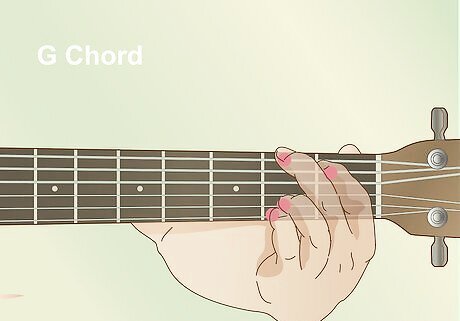
Play a G chord. Like the C and the F, the G chord is one of the Big Three in the C major scale. There are many ways to play it, and we'll show you two. The first way is easy: it's the exact same fingering as the extended F chord, only moved up two frets:
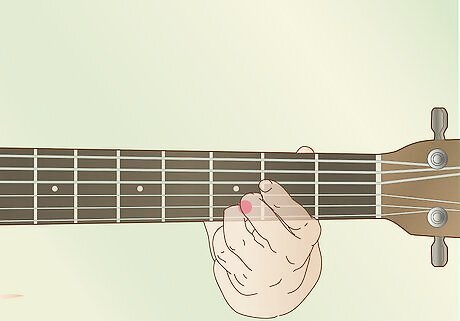
Play the G chord the easy way. Here's a way to play the G chord with only one finger:

Put it all together. Now that you know the three basic chords in the key of C, put them together, and perhaps you'll recognize about a zillion popular songs. Strum C four times, followed by F, two times, then G, two times, then back to C. Note that after each chord is a Roman numeral. These indicate what position the root note of the chord is on the scale—regardless of fingering. Once you know the basic chords in all the keys, it's easier to just show a chart than to have the chord spelled out every time. Practice that until your fingers are tired, then take a break, but come back: we'll also show you the basic chords in E and A!
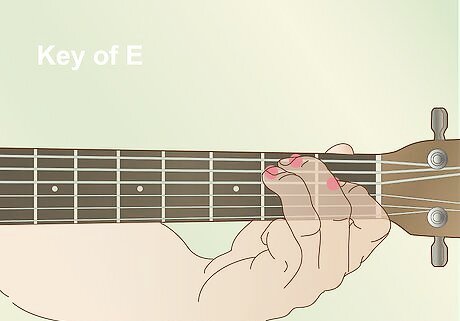
Learn the key of E. There's a lot of rock 'n' roll done in the key of E, and a lot of blues, too. The three chords to learn here are E Maj (I), A Maj (IV), and B Maj (V). Here's the E chord: This is one of the easier chords to play, once you have your calluses built up. You can play all the strings at once. Crank up a Marshall stack to 11 with this chord, hit it hard, and you'll feel the beginnings of being a rock hero!

Play the A Major. This is another "big chord," sonically. There are several ways to play this. You can use one finger across the 2nd fret of the B, G, and D strings (playing C#, A, and E, respectively), or any other combination of fingers. For this example, we'll use the 4th finger on the B string, 3rd finger on the G string, and 2nd finger on the D string. As you get better at playing, you will understand that moving quickly from one chord to another sometimes results in odd fingerings that still work. The key is to make the most efficient use of your fingers, and once you kick off the training wheels, don't be afraid to experiment.

Play the B Major. You can play this one easy, or play this one hard. The easy way is shown with the black numbers. You can add the additional note, show by the gray number.
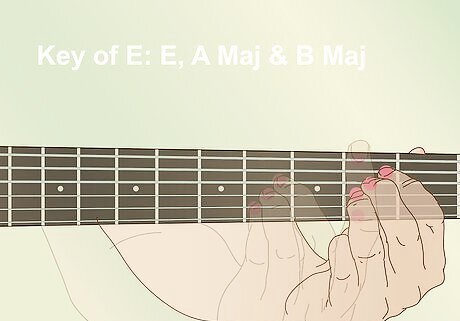
Try it out. Here's another short strumming pattern to try out in the key of E: Try varying your strumming pattern, too: don't just stick to the lines on the paper.
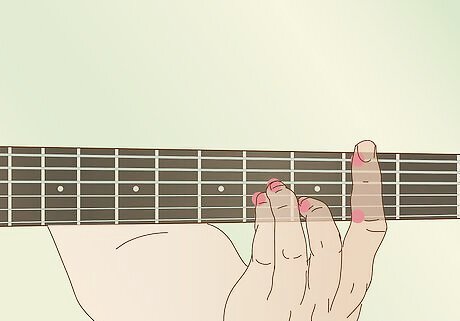
Learn the key of A. You're already two thirds of the way there! The key of A consists of A in the first position (I), D in the fourth position (IV), and our old powerhouse friend E in the dominant fifth position (V). Here's how to play the D chord: Note the first finger across the first three strings: this is the beginning of a "barre" chord. A full barre chord uses one finger across all strings, and is often based on the basic forms shown in this article.
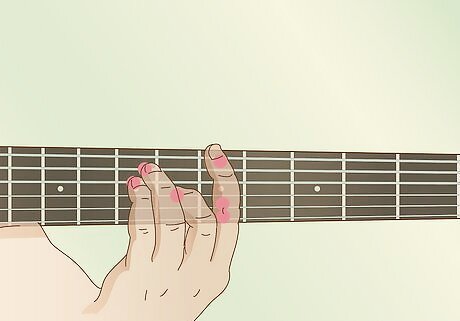
Learn an alternate version of the A chord. This is useful when played along with the D and the E chords:
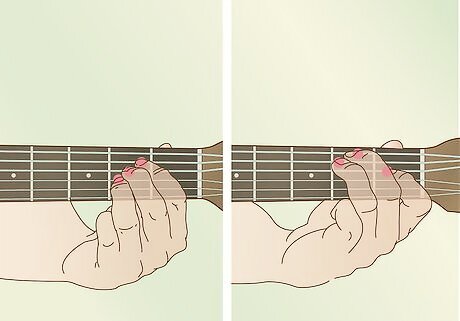
Try it out. Here's another Little Ditty to try out your new chords on: Now, think of the Creedence Clearwater Revival song, Down on the Corner, and try it again!
Using Video Chord Diagrams

Learn a G major. Your ring finger goes on the top string, 3rd fret. The middle finger is for the 5th string, 2nd fret, and you pinky goes all the way to the bottom, on the 3rd fret of the 1st string. Strum all of the strings together to play the chord. If you want, add in the 3rd fret, 2nd string -- this not is not necessary, but makes a richer sounding chord. --3-- --0-- --0-- --0-- --2-- --3--

Learn a C major. Place your ring finger up on the 5th string, 3rd fret. Then follow with your middle finger 4th string, 2nd fret -- note how this is the same beginning as a G chord, just moved down a string. Then end with your index finger on the 2nd string, 1st fret. Play all but the top string. --0-- --1-- --0-- --2-- --3-- --X--
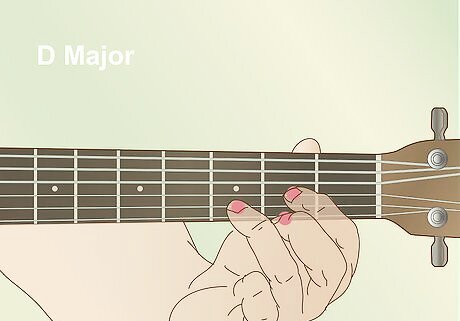
Learn a D major. This chord only requires the bottom four strings. Place your index finger on the 3rd string, 2nd fret. Your ring finger then goes on the 2nd string, 3rd fret, and your middle finger is the 1st string, second fret. You'll form a little triangle shape. Only strum these three strings and the 4th string -- the open D -- to sound out the chord. --2-- --3-- --2-- --0-- --X-- --X--
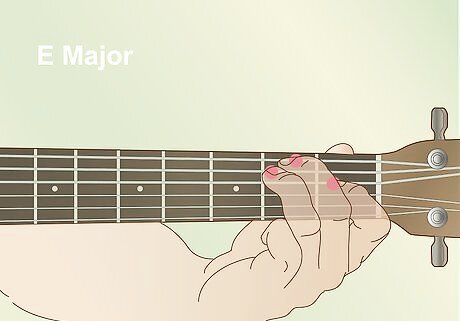
Learn an E minor and major. This deep chord uses all six strings. Place your middle and ring fingers on the 2nd frets of the 4th and 5th strings. Then place your index finger on the 3rd string, 1st fret. Strum all six strings. --0-- --0-- --1-- --2-- --2-- --0-- Make an E-minor chord by simply removing your index finger, leaving the 3rd string open.
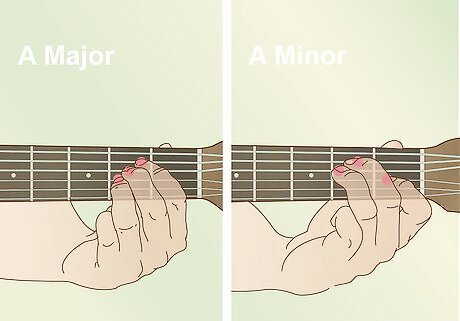
Learn an A Major and minor. An A major is one of your easiest chords -- simply use your index, ring, and middle finger to fret the 2nd fret on the 2nd, 3rd, and 4th strings. Play every string but the low-E string. --0-- --2-- --2-- --2-- --0-- --X-- Make an A-minor chord by playing the first fret, not the second, on the B string. The shape is identical to E-major.
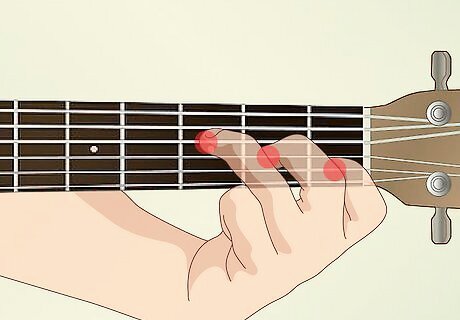
Learn an F major. F resembles a C major chord, just smushed. Ignore the top two strings. Place your ring finger on the 4th string, 3rd fret. Your middle finger goes 3rd string, 2nd fret. Finally, the index finger goes on the 2nd string, 1st fret. Play only the bottom four strings. --0-- --1-- --2-- --3-- --X-- --X--










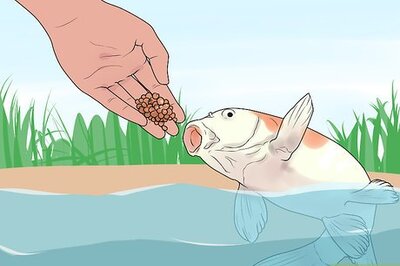
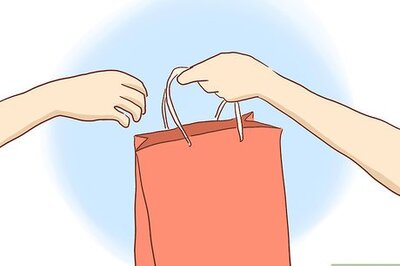





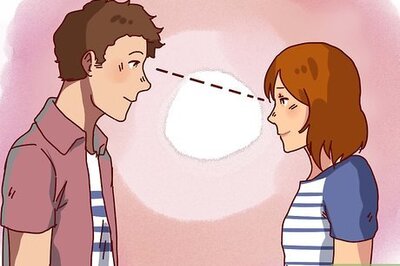

Comments
0 comment